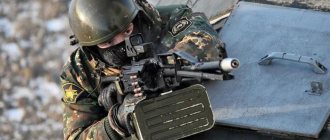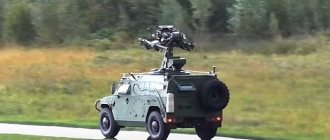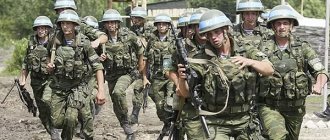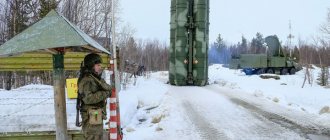New Military Doctrine of the Russian Federation
At the end of December last year, the Russian Security Council approved, and President Vladimir Putin approved, amendments to the existing Military Doctrine. In connection with a number of changes in the international military-political situation observed recently, the Russian leadership is forced to take appropriate measures and edit existing documents that form the basis of the state’s defense strategy. Since December 26, the basis of the country’s defense has been the updated Military Doctrine. The previous version of the document was adopted in February 2010. The nature of the amendments is such that most of the points in the document remain unchanged. However, some provisions of the Doctrine were moved within the document, and also changed, supplemented or reduced to one degree or another. Although the changes made appear to be small, they have a major impact on both Military Doctrine and various features of its implementation. Let's look at the updated document and the adjustments made that distinguish it from the previous Doctrine.
The first section of the updated Military Doctrine, “General Provisions,” has undergone minimal changes. Its structure has changed slightly. Thus, the list of strategic planning documents underlying the Doctrine was changed and placed in a separate paragraph. Almost all definitions of terms used in the documents remain the same, although some have been revised. For example, the terms “military security”, “military threat”, “armed conflict”, etc. it is proposed to interpret it in the old way, and in the definition of the concept of “regional war” there is now no mention of the possible use of nuclear and conventional weapons, as well as the conduct of battles on the territory of the region, in adjacent waters and air or space above it.
The revised Military Doctrine introduces two new concepts: the mobilization readiness of the Russian Federation and the non-nuclear deterrence system. The first term refers to the ability of the armed forces, the state economy and government authorities to organize and implement mobilization plans. The non-nuclear deterrence system, in turn, is a set of military, military-technical and foreign policy measures aimed at preventing aggression through non-nuclear measures.
Very noteworthy changes are observed in the second section of the Military Doctrine, “Military dangers and military threats to the Russian Federation.” Already in the first paragraph of this section (previously it was 7th, but due to some changes in the structure of the document it became 8th) changes in the geopolitical situation in the world are reflected. Previously, a characteristic feature of world development was the weakening of ideological confrontation, a decrease in the level of economic, political and military influence of some states or groups of countries, as well as the growth of influence of other states.
Now the authors of the document consider the main trends to be the strengthening of global competition and tension in various areas of interregional and interstate cooperation, the rivalry of value guidelines and development models, as well as the instability of economic and political development at various levels, observed against the backdrop of a general deterioration in relations in the international arena. Influence is gradually being redistributed in favor of new centers of political gravity and economic growth.
Recent events have led to the emergence of paragraph 11, according to which there has been a tendency to shift military dangers and threats into the information space and the internal sphere of Russia. It is noted that with a decrease in the likelihood of a large-scale war against the Russian Federation in some areas, the risks increase.
Paragraph 8 of the new Military Doctrine lists the main external military dangers. Most of the listed dangers remained unchanged, but some subparagraphs were changed, and new ones appeared. For example, the subclause on the threat of international terrorism and extremism has been seriously expanded. The authors of the Doctrine argue that such a threat is growing, and the fight against it is insufficiently effective. As a result, there is a real threat of terrorist attacks using toxic and radioactive materials. In addition, the scale of international organized crime, primarily arms and drug trafficking, is increasing.
The updated Military Doctrine contains three new external military dangers that were absent in the previous version of the document: - the use of information and communication technologies for military-political purposes to carry out actions directed against political independence, territorial integrity and sovereignty, as well as posing a threat to regional and global stability ; — changes in the ruling regime in neighboring countries (including through a coup d’etat), as a result of which the new authorities begin to pursue policies that threaten the interests of Russia; — subversive activities of foreign intelligence services and various organizations.
The item “Main internal military threats” has been added, revealing potential threats that do not have a direct connection with external military aggression. Internal military dangers include: - activities aimed at violently changing the constitutional system of Russia, as well as destabilizing the social and internal political situation, disrupting the work of government bodies, military facilities or information infrastructure; - activities of terrorist organizations or individuals intending to undermine the sovereignty of the state or violate its territorial integrity; — information impact on the population (primarily on young people), aimed at undermining historical, spiritual and patriotic traditions associated with the defense of their country; — attempts to provoke social and ethnic tension, as well as incitement to hatred on ethnic or religious grounds.
Paragraph 12 of the Doctrine lists the characteristic features of modern military conflicts. In a number of subparagraphs, this part of the Military Doctrine corresponds to its previous version, but has significant differences. Thus, subparagraph “a” previously looked like this: “complex use of military force and non-military forces and means.” In the new edition, it mentions political, economic, informational and other non-military measures. In addition, such measures can be implemented using the protest potential of the population and special operations forces.
The list of weapon systems presenting a threat, presented in subparagraph “b,” has been expanded. In addition to high-precision and hypersonic weapons, electronic warfare systems and systems based on new physical principles, the updated Doctrine mentions information and control systems, as well as robotic weapons systems and equipment, including unmanned aerial vehicles and autonomous marine vehicles.
The following list of characteristic features of modern conflicts has been seriously changed. Now it looks like this: - impact on the enemy throughout the depth of his territory, at sea and in aerospace. In addition, influence in the information space is used; - high degree of target destruction and selectivity, as well as speed of maneuver both by troops and fire. Mobile troop groups are becoming increasingly important; — reduction of preparation time for combat operations; — transition from a strictly vertical troop control system to global networked automatic systems, which leads to increased centralization and automation of force control; — creation of a permanent zone of armed conflict on the territories of the warring parties; — active participation in conflicts of private military companies and various irregular formations; — use of indirect and asymmetric actions; - financing of political and social movements used to achieve certain goals.
Despite the changing face and nature of modern armed conflicts, nuclear weapons are still and will continue to be an important factor in preventing armed conflicts using conventional and nuclear weapons. A similar thesis is reflected in paragraph 16 of the updated Military Doctrine.
Section III of the new Military Doctrine is devoted to the military policy of the Russian Federation. Paragraph 17 of the previous edition was divided into two. The new 17th paragraph stipulates the procedure for determining the main tasks of the state’s military policy. They must be determined in accordance with federal legislation, the National Security Strategy, etc.
Paragraph 18 states that Russia's military policy is aimed at containing and preventing military conflicts, improving the armed forces and other structures, and increasing mobilization readiness in order to protect the Russian Federation and its allies. An interesting fact is that in the previous version of the Military Doctrine, one of the goals of military policy was to prevent an arms race. There is no such goal in the new document.
Paragraph 21 stipulates the main tasks of Russia in containing and preventing conflicts. In the new edition, this paragraph has the following differences from the previous version: - subparagraph “e” requires maintaining the mobilization readiness of the economy and government bodies at different levels; — subparagraph “e” implies the unification of the efforts of the state and society in protecting the country, as well as the development and implementation of measures to increase the effectiveness of military-patriotic education of citizens and the preparation of youth for military service; — subparagraph “g” is a modified version of subparagraph “e” of the previous version of the Doctrine and requires expanding the circle of partner states. An important innovation is the expansion of interaction with countries included in the BRICS organization; — subparagraph “h” (formerly “e”) concerns strengthening the collective security system within the CSTO, as well as strengthening cooperation between the CIS countries, the OSCE and the SCO. In addition, Abkhazia and South Ossetia are mentioned as partners for the first time.
The following subparagraphs of paragraph 21 are completely new: k) creation of mechanisms for mutually beneficial cooperation in countering potential missile threats, up to the joint creation of missile defense systems with equal participation of the Russian side; l) countering attempts by states or groups of states to ensure their military superiority through the deployment of strategic missile defense systems, the placement of weapons in space or the deployment of strategic high-precision non-nuclear weapons; m) conclusion of an international agreement prohibiting the placement of any weapons in outer space; o) harmonization within the UN of systems for regulating the safe conduct of activities in outer space, incl. safety of operations in space from a technical point of view; n) strengthening Russian capabilities in the field of monitoring objects and processes in near-Earth space, as well as cooperation with foreign countries; c) creation and adoption of mechanisms for monitoring compliance with the Bacteriological and Toxin Weapons Convention; s) creating conditions aimed at reducing the risk of using communication and information technologies for military-political purposes.
The 32nd paragraph of the Military Doctrine defines the main tasks of the armed forces, other troops and bodies in peacetime. The new Doctrine contains the following modifications: - subparagraph “b” mentions strategic deterrence and prevention of military conflicts using both nuclear and conventional weapons; — in subparagraph “i” the approach to the creation of military infrastructure has been changed. It is now proposed to create new and modernize existing facilities, as well as select dual-use facilities that can be used by the armed forces for defense purposes; — the updated subparagraph “o” contains a requirement to combat terrorism on the territory of Russia, as well as to suppress the activities of international terrorist organizations outside the state; — subparagraph “y” has been added, according to which the new task of the armed forces is to ensure Russia’s national interests in the Arctic.
Clause 33 (formerly clause 28) stipulates the main tasks of the armed forces, other troops and bodies during the period of immediate threat of aggression. In general, it corresponds to the previous edition, but has a new subclause. The updated Military Doctrine contains a sub-clause on the strategic deployment of armed forces.
Paragraph 35 reflects the main tasks of the military organization. Like other provisions of the new Doctrine, this paragraph is slightly different from the previous version and has the following innovations: - in subparagraph “c”, instead of improving the air defense system and creating an aerospace defense system, the improvement of the existing aerospace defense system is indicated; — the new subparagraph “n” indicates the need to develop a mobilization base and ensure the mobilization deployment of the armed forces; — the new subparagraph “o” also requires improving the system of radiation, chemical and biological protection of troops and civilians.
The new edition of paragraph 38 of the Military Doctrine, which talks about the prerequisites for the construction and development of the armed forces, differs from the previous one in two subparagraphs: - subparagraph “d” notes the need to improve the interaction of both types and branches of the military, as well as the armed forces and government bodies; — subparagraph “g” includes the need to improve the system of military education and training, personnel training and military science in general.
Paragraph 39 reveals methods and means of building and developing the armed forces and other structures. Clause 39 differs from the previous edition in the following features: - in subparagraph “g”, instead of creating a civil defense force of permanent readiness, the development of this structure is indicated; — new subparagraph “h” implies the formation of territorial troops to protect military facilities and civilian infrastructure; — subparagraph “n”, instead of the previously carried out optimization of the number of military educational institutions, proposes improving the structure of the personnel training system.
The points of the new Military Doctrine relating to mobilization preparation and mobilization readiness of the Russian Federation have been almost completely revised. In addition, these provisions have been moved from the fourth section of the doctrine to the third, which determines the military policy of the state.
According to the new doctrine (clause 40), the country’s mobilization readiness is ensured by preparation for the implementation of mobilization plans on time. The given level of mobilization readiness depends on the predicted threats and the nature of the potential conflict. The given level must be achieved through mobilization preparation measures and updating the material part of the armed forces.
The main objectives of mobilization preparation are defined in paragraph 42: - ensuring sustainable public administration in wartime; — creation of a legislative framework regulating the operation of the economy, etc. in wartime; — meeting the needs of the armed forces and the population; - creation of special formations, which, when mobilization is announced, can be transferred to the armed forces or employed in the interests of the economy; — maintaining industrial potential at the level necessary to satisfy all needs; — providing the armed forces and economic sectors with additional human, material and technical resources in wartime conditions; — organization of restoration work at facilities damaged during hostilities; — organizing the provision of food and other goods to the population in conditions of limited resources.
Section IV “Military-economic support of defense” is devoted to the peculiarities of the economic aspects of the construction and modernization of the armed forces. Due to the implementation of a number of programs and projects, the section on military-economic support for defense is seriously different from the corresponding paragraphs of the previous version of the Military Doctrine. Let's consider the innovations of the updated Doctrine.
The difference between the old and new editions of Section IV is visible from the first paragraphs. It becomes especially noticeable in paragraph 44, “Tasks of military-economic support for defense.” The new Doctrine defines the following tasks: - equipping the armed forces and other structures with modern weapons and military equipment created using the military-scientific potential of the country; — timely provision of the armed forces with funds for the implementation of construction and employment programs, as well as training of troops; — development of the military-industrial complex through coordination of the military-economic activities of the state; — improving cooperation with foreign states in the military-political and military-technical spheres.
Paragraphs 52 and 53 are devoted to the development of the defense-industrial complex. It is noteworthy that in the new edition they received minimal changes. Thus, in paragraph 53, which describes the tasks of the development of the defense industry, an additional subclause has been added, according to which it is necessary to ensure the production and technological readiness of defense industry organizations to create and produce priority types of weapons and equipment in the required volumes.
Russia conducts active military-political and military-technical cooperation with various foreign countries. This partnership is also reflected in the updated Military Doctrine. Paragraph 55 (formerly paragraph 50) describes the tasks of military-political cooperation and has the following differences from the previous version: - fulfillment of international obligations is included in a separate subparagraph “g”, and subparagraph “a” speaks of strengthening international security and strategic stability in the global and regional level; — the list of states with which it is proposed to cooperate, in addition to the CSTO and CIS countries, includes Abkhazia and South Ossetia; — it is proposed to develop a dialogue with interested states.
Paragraph 56 reveals the list of the main partners of the Russian Federation, and also indicates the priorities of cooperation with them. The Military Doctrine indicates the priorities of cooperation with the Republic of Belarus, the countries of the CSTO, CIS and SCO organizations, as well as with the UN and other international organizations. For certain reasons, these subparagraphs of paragraph 56 have not changed in comparison with the previous edition of the Doctrine. At the same time, a new sub-clause appeared in paragraph 56, dedicated to Russia’s cooperation with Abkhazia and South Ossetia. The priority area of military-political cooperation with these states is mutually beneficial work to ensure joint defense and security.
As before, the tasks of military-technical cooperation must be determined by the president in accordance with existing federal legislation (clause 57). The main directions of military-technical cooperation with foreign countries should be formulated by the president in his Annual Address to the Federal Assembly.
As before, the updated Military Doctrine contains a separate clause, according to which the provisions of this document can be finalized and clarified in connection with the changing nature of potential threats and tasks of ensuring the security of the Russian Federation.
Text of the 2010 Military Doctrine: https://news.kremlin.ru/ref_notes/461
Text of the 2015 Military Doctrine: https://news.kremlin.ru/media/events/files/41d527556bec8deb3530.pdf










